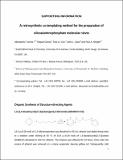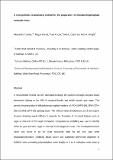Files in this item
A retrosynthetic co-templating method for the preparation of silicoaluminophosphate molecular sieves
Item metadata
| dc.contributor.author | Turrina, Alessandro | |
| dc.contributor.author | Garcia, Raquel | |
| dc.contributor.author | Cox, Paul | |
| dc.contributor.author | Casci, John | |
| dc.contributor.author | Wright, Paul Anthony | |
| dc.date.accessioned | 2017-06-17T23:33:40Z | |
| dc.date.available | 2017-06-17T23:33:40Z | |
| dc.date.issued | 2016-07-26 | |
| dc.identifier | 243606280 | |
| dc.identifier | 2c3c06c2-b154-4d05-9446-1d97608b870d | |
| dc.identifier | 84979873030 | |
| dc.identifier | 000380576700016 | |
| dc.identifier.citation | Turrina , A , Garcia , R , Cox , P , Casci , J & Wright , P A 2016 , ' A retrosynthetic co-templating method for the preparation of silicoaluminophosphate molecular sieves ' , Chemistry of Materials , vol. 28 , no. 14 , pp. 4998-5012 . https://doi.org/10.1021/acs.chemmater.6b01676 | en |
| dc.identifier.issn | 0897-4756 | |
| dc.identifier.other | ORCID: /0000-0002-4243-9957/work/62668240 | |
| dc.identifier.uri | https://hdl.handle.net/10023/11015 | |
| dc.description | This work has been supported by Johnson Matthey PLC, UK. Solid-state NMR spectra were obtained at the EPSRC UK National Solid-state NMR Service at Durham. | en |
| dc.description.abstract | A retrosynthetic method has been developed to design the synthesis of target zeotypes whose frameworks belong to the ABC-6 structural family and which contain gme cages. This permits the preparation of silicoaluminophosphate versions of AFX (SAPO-56), SFW (STA- 18) and GME (STA-19) topology types. The method makes simultaneous use of two organic structure directing agents (SDAs) to promote the formation of structural features such as cages or channels of the target framework. Computational modelling was used to identify SDAs for gme and other cages or channels in the target structures. The trimethylammonium cation was found to be the most favourable SDA for the gme cage while bisdiazabicyclooctane (DABCO) alkane cations and quaternary ammonium oligomers of DABCO with connecting polymethylene chain lengths of 4 to 8 methylene units acted as 1 templates for the additional cages or channels, respectively. The incorporation of each of the co-SDAs in the as-prepared materials was confirmed by chemical analysis, 13C MAS NMR and Rietveld refinement combined with computational modeling. Calcination of the SAPO- 56, STA-18 and some of the STA-19 materials gives microporous, fully tetrahedrally- coordinated framework solids with AFX, SFW and GME topologies: other STA-19 samples convert topotactically to SAPO-5. These results show that SAPOs in the ABC-6 family can be prepared via a targeted co-templating approach. | |
| dc.format.extent | 15 | |
| dc.format.extent | 1657698 | |
| dc.format.extent | 1471548 | |
| dc.language.iso | eng | |
| dc.relation.ispartof | Chemistry of Materials | en |
| dc.subject | QD Chemistry | en |
| dc.subject | DAS | en |
| dc.subject.lcc | QD | en |
| dc.title | A retrosynthetic co-templating method for the preparation of silicoaluminophosphate molecular sieves | en |
| dc.type | Journal article | en |
| dc.contributor.institution | University of St Andrews. School of Chemistry | en |
| dc.contributor.institution | University of St Andrews. EaSTCHEM | en |
| dc.identifier.doi | 10.1021/acs.chemmater.6b01676 | |
| dc.description.status | Peer reviewed | en |
| dc.date.embargoedUntil | 2017-06-17 |
This item appears in the following Collection(s)
Items in the St Andrews Research Repository are protected by copyright, with all rights reserved, unless otherwise indicated.


